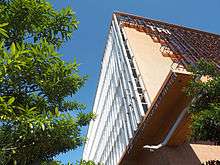Translational Research Institute (Australia)
 The Translational Research Institute | |
| Founder(s) | Professor Ian Frazer AC |
|---|---|
| Established | October 2013 |
| Mission | Medical research |
| Focus | Translational |
| Chief Executive Officer | Carolyn Mountford |
| Faculty | |
| Adjunct faculty | Brisbane Diamantina Health Partners |
| Staff | 650 |
| Location | Kent Street, Woolloongabba, Brisbane, Queensland, Australia |
| Website |
www |
The Translational Research Institute (TRI) is Australia’s first translational medical research institute dedicated to translating scientific discoveries into applications for medical practice.[1]
Located in Woolloongabba, in inner-city Brisbane, Queensland, was founded in 2013 through a partnership between The Atlantic Philanthropies, the Australian Government, the Queensland Government, The University of Queensland (UQ), Queensland University of Technology (QUT), Mater Research, a division of Mater Health Services and Metro South, a division of Queensland Health, to combine clinical and translational research to advance progress from laboratory discovery to application in patient care.[2]
The institute combines academic medicine and translational research, in order to minimise the time between a laboratory discovery and its effective application in the clinic and the community.[3] To further this goal, the TRI is a member of the Brisbane Diamantina Health Partners, Queensland's first academic health science system.
History
In 2004 a proposal was submitted to the Queensland Government for the development and construction of TRI. In 2007 this progressed to project design. Five years on and A$354 million in funding from the Australian and Queensland Governments, The Atlantic Philanthropies, UQ and QUT, TRI became operational and four institutes came together.[4] TRI was officially opened in October 2013 by the Governor-General Dame Quentin Bryce.[4]
Research
Over 650 researchers from TRI’s four partner organisations undertake medical research into cancer; inflammation and infection; obesity and diabetes; kidney disease and liver disease; and bone and joint disorders.[2][4]
TRI research aims to:
- prevent disease and provide protection against infection
- understand diseases to improve early detection, diagnosis, treatment and recovery
- reduce the risk of disease spreading
- relieve symptoms and better manage chronic diseases and trauma.
Researchers
Some of TRI's researchers include:
- Professor Ian Frazer AC - known for the development of the HPV vaccine against cervical cancer.
- Professor Carolyn Mountford - Current TRI CEO, known for magnetic resonance spectroscopic imaging.
- Judith Clements AC - known for Kallikrein proteases in prostate and ovarian cancers.
- Professor Elizabeth Powell - known for establishing an internationally recognised liver research group.
- Josephine Forbes - specialises in the study of glycation and diabetes.
- Glenda Gobe - specialises in the molecular controls of apoptosis in kidney disease.
Facilities
Located on the Princess Alexandra (PA) Hospital campus, the seven-story TRI building incorporates four floors of state-of-the art laboratories; and facilities for research support, administration and teaching.[4][5]
TRI's core facilities include:
- Clinical Research Facility
- Cytometry Core Facility
- Histology Core Facility
- Microscopy Core Facility
- Proteomics Facility
- The University of Queensland Centre for Clinical Genomics (UQCCG)[6]
Co-located with TRI are the following facilities:
- Patheon Biologics, the first major biopharmaceutical manufacturing facility in Australia.
- The University of Queensland Diamantina Institute’s Centre for Clinical Genomics, the largest human genomic facility in the southern hemisphere, enabling researchers to study the whole genome, and map single genes associated with common diseases.[7]
- Brisbane Diamantina Health Partners Academic Health Science System
The TRI building
The TRI building was designed by Wilson Architects + Donovan Hill and was built by WATPAC, completed in 2012 at the total cost of $354 million.[8] The facility features eight levels: four levels of laboratories, administration and teaching facilities, an auditorium and conference rooms, staff amenities and an "outdoor room" atrium area. TRI is a 32,000 square metres (340,000 sq ft) building, making it the largest medical research institute in the southern hemisphere. It stands on the grounds of the Princess Alexandra Hospital in Brisbane on the former site of the Vision Australia building, of which the red clay bricks were salvaged and reused as the base of TRI.[5][9]
The building received several architectural and design awards.[10][11][12][12]
See also
References
- ↑ "Construction begins on Australia's first Translational Research Institute". Australian Trade Commission. Australian Government. Retrieved 16 August 2014.
- 1 2 "TRI Story". The Translational Research Institute.
- ↑ "Translational Research Institute". Queensland Government. Retrieved 16 August 2014.
- 1 2 3 4 "Official opening of the translational research institute". Governor General of the Commonwealth of Australia. Retrieved 16 August 2014.
- 1 2 "State-of-the-art facility". The Translational Research Institute. Retrieved 16 August 2014.
- ↑ "TRI Facilities". Translational Research Institute. Retrieved 6 January 2015.
- ↑ "UQ Diamantina Institute". Australia's Academic and Research Network. Retrieved 16 August 2014.
- ↑ "A state-of-the-art facility". Translational Research Institute. Retrieved 7 January 2015.
- ↑ "Translational Research Institute". ArchitectureAU. Retrieved 1 January 2015.
- ↑ "Master Builders: Project of the Year". Master Builders. Retrieved 16 August 2014.
- ↑ "Master Builders: Construction Awards". Master Builders.
- 1 2 "Queensland Awards: State Architecture Awards". Australian Institute of Architects. Retrieved 16 August 2014.